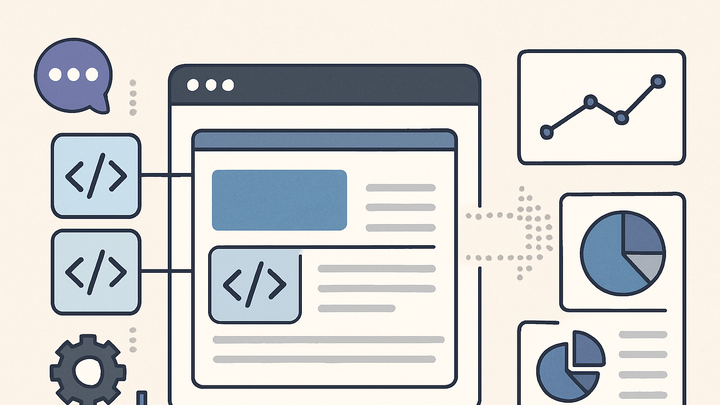Published on 2025-06-22T04:30:17Z
What is a Plugin? Examples of Analytics Plugins
An analytics plugin is a self-contained code module that integrates into a web analytics framework to provide additional tracking capabilities. Plugins can capture specialized events, integrate with third-party services, or handle data processing without requiring changes to the core library. For example, PlainSignal’s cookie-free plugin enables privacy-focused real-time tracking across domains with a simple code snippet:
<link rel="preconnect" href="//eu.plainsignal.com/" crossorigin />
<script defer data-do="yourwebsitedomain.com" data-id="0GQV1xmtzQQ" data-api="//eu.plainsignal.com" src="//cdn.plainsignal.com/plainsignal-min.js"></script>
Meanwhile, Google Analytics 4 (GA4) offers built-in plugins such as Enhanced Measurement to automatically track scrolls, outbound clicks, and video engagement. Using plugins offers modularity, maintainability, and performance benefits by loading only the features you need. They help teams implement complex analytics workflows faster and maintain cleaner codebases. Plugins often include configuration options like data attributes or API keys, and they can be installed via script tags or package managers. By encapsulating features like consent management or data anonymization, plugins also support compliance with privacy regulations like GDPR and CCPA.
Plugin
A plugin is a modular extension that enhances analytics platforms with custom tracking features and integrations.
Understanding Analytics Plugins
An overview of what analytics plugins are and why they matter in web data collection and reporting.
-
Definition
A plugin in analytics is a modular piece of code that extends the functionality of your core tracking library or platform without modifying its source.
-
Key benefits
Plugins offer modularity, customization, and easier maintenance for analytics implementations.
-
Modularity
Encapsulates features into separate units, so you can enable or disable them independently.
-
Customization
Allows tailoring of tracking logic to specific business requirements or user interactions.
-
Performance
Loads only the necessary code, reducing bloat and improving page load times.
-
Popular Analytics Plugins and SaaS Examples
Explore well-known analytics plugins, including SaaS offerings like PlainSignal and GA4.
-
PlainSignal cookie-free analytics
A lightweight plugin that enables privacy-compliant, cookie-free tracking with minimal setup.
-
Integration code
Add the following snippet to your site’s
<head>to load the PlainSignal plugin:<link rel="preconnect" href="//eu.plainsignal.com/" crossorigin /> <script defer data-do="yourwebsitedomain.com" data-id="0GQV1xmtzQQ" data-api="//eu.plainsignal.com" src="//cdn.plainsignal.com/plainsignal-min.js"></script> -
Features
Real-time dashboards, event tracking, cross-domain support, and compliance with GDPR/CCPA.
-
-
Google analytics 4 (GA4) plugins
GA4 uses plugin architecture within gtag.js and the Measurement Protocol to extend functionality.
-
Enhanced measurement
Automatically tracks scroll depth, outbound link clicks, site searches, video engagement, and more.
-
Custom plugin example
Use
gtag('config', 'GA_MEASUREMENT_ID', { 'plugin_name': [options] })or call Measurement Protocol endpoints directly for server-side customizations.
-
Implementing and Managing Plugins
Best practices for adding, configuring, and maintaining analytics plugins effectively.
-
Installation
Include the plugin via script tags or install it through a package manager in modern web frameworks.
-
Script tag
Use a
<script>tag for simple, standalone deployments. -
Npm/yarn package
Install via
npm installoryarn addfor integration into frameworks like React, Vue, or Angular.
-
-
Configuration
Customize plugin behavior by passing data attributes, API keys, or initialization options.
-
Data attributes
Set attributes like
data-idordata-apito link your site to the plugin service. -
Event mapping
Map your site’s custom events to the plugin’s tracking methods or events.
-
-
Testing and debugging
Validate plugin integration and troubleshoot issues to ensure accurate data collection.
-
Browser devtools
Inspect network requests and console logs to verify plugin requests and errors.
-
Plugin dashboards
Use the plugin’s administrative UI to confirm event reception and configuration status.
-
